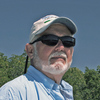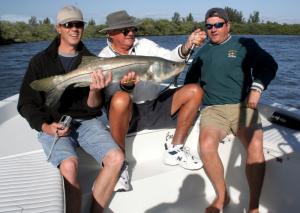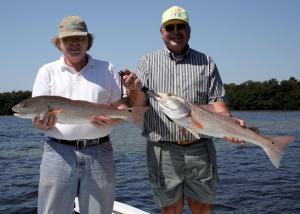Is this a great time of the year to live in Florida… or what? Mild weather for most of the winter with only a few cold mornings then it warms nicely by noon. Typical wintertime fishing in upper and lower Tampa Bay, with one exception there are Sheepshead everywhere. Seems like thousands of them hanging around oyster bars, docks, pilings, and bridge fenders and they're willing to eat. Speaking of eating, these guy's are delicious.
Feeding mostly on shellfish or shrimp, their white meat resembles lobster according to Capt. Mel Berman of the Capt. Mel Radio Show. Mel cubes the meat, cooks it on the grille and serves it with drawn butter… sounds great. Anglers are catching plenty of jacks around power plants or schools of mullet. Talk about some rod bending fun… hook up with a 10 to 15 lb Jack Cravelle "If you think fishing for sissy's… you don't know Jack"! Not fussy they eat just about anything cast in their direction and retrieve quickly. Be prepared to give chase on larger fish or buy more fishing line on the way home. Catches of Spotted Sea Trout been spotty at best. No pun intended but it works. Lower Tampa Bay, normally teaming with nice specks seemed almost barren according several anglers fishing the area.
Even the Clearwater bite was off this year. Some attribute it to the Red Tide others say that large numbers of anglers fishing Clearwater put too much pressure on them. There where days when you could not drift a flat without bumping into another boat doing the same. Fishing pressure of this magnitude takes a toll on the numbers of fish taken or improperly released and left to die. Live bait anglers get excited this month as the bait starts showing up in Tampa Bay. They can expect good days on Snook, Reds, Trout, Mackerel and toward the end, the Tarpon begin showing up on the beach and around bridges. Those electing to use artificial lures should be pleasantly surprised to find the fish willing to eat topwater and soft plastics. THE NEW RULES REMINDER: The Florida Fish and Wildlife Conservation Commission (FWC) approve new rules to standardize how anglers measure the total length of various saltwater finfish. The Commission approved the Total Length Maximum Measurement Method. This new method takes effect July 1, 2006. The new rules specify that the "total length" of saltwater fish, such as RED DRUM, SPOTTED SEA TROUT and SNOOK be measured by determining the straight-line distance from the most forward point of the head to the farthest tip of the tail. Take measurements with the mouth closed and the tail compressed or squeezed together with the fish lying on its side. However, there is no change in other "forked tail" saltwater species like, Spanish mackerel, pompano, and cobia. Fork length measurements considered easily understood by anglers need no further clarification. To better understand, how to measure saltwater fish visit the following Florida Wildlife Commission website: http://www.myfwc.com/marine/Fishing_Measurement.htm IT'S MY OPINION: Snook, the most tightly regulated fish in Florida may soon be in danger again.
Many anglers today agree with the current management and measurement theories now in place. However, for the conservation-minded angler, viewing snook more as catch-and-release should be concerned about these new measurement guidelines. According to Ron Taylor, FMRI Snook Scientist these new measuring rules can influence our already struggling Snook populations. By all indications, pinching the tail can allow the taking of young healthy egg producing females measuring from 23.5 to 26 inches instead of the current 26 to 34 inches. From the recent stock assessment conducted by the FMRI, West Coast Snook show a slight population recovery. However, with these new rules, the hard fought road to recovery could quickly u-turn affecting any progress already made.
SNOOK: As the water continues warming, snook become more active. Fish deeper passes early then transition into the shallower water as the day progresses. Greenbacks and Threadfins produce excellent live bait action. If topwater action with artificial lures is you thing, try any walk-the-dog action like MirrOlure Top Dogs or Original High Roller Lures early. Then switch to Old BaySide soft plastics later in the day. Rig them on a 1/16th or 1/8th ounce jig head and work them in a jerky, crank and retrieve action. Cast them close to the mangroves and working them away slowly. Upper Tampa Bay, Rocky Creek, Double Branch, and 4th Street, Big Island, Picnic Island, Coffee Pot Bayou and Weedon Island produce well in the North End. In the south look around the Kitchen, Simmons Park, Little Manatee River, Cockroach Bay, Piney Point Creek, Joes Island, Fort Desoto Flats, Boca Ciega Bay and Bishops Harbor.
REDFISH: Redfish are tolerable of the colder water and feed well practically year around. Most active between the mid sixties and low eighties they cruise the outer flats then follow the tides as they travel in and out of the mangroves. Mullet…Mullet…Mullet… are good bets for finding Redfish. Topwater artificial's or soft plastic lures on early morning, broken bottom flats, and around the mangroves produce nice catches. Weedon Island, Double Branch, Piney Point Creek, Simmons Park, Kitchen, Cockroach Bay, Bishops Harbor outside flats, Ft. Desoto and Joe Island usually produce schooling Redfish.
SPOTTED SEA TROUT: For fast excitement, cast topwater popping lures over calm early morning flats, especially during incoming and outgoing tides,. Pop the lure several times, let it sit, pop it again, let it sit and be ready. Sometimes the excitement just kills you… it's going to happen you're just not sure when. Remember when the strike happens… do not set the hook until you feel the fish. Anglers get so excited at the strike they snatch the lure out of the strike zone. On any good grass flat live shrimp, under a Paradise Popper from Old BaySide always produces nice catches. Over the years, Sea Trout were plentiful around Pinellas Point, Joe Island, Bishop Harbor and Ft. Desoto flats. However, with the Red Tide last year we'll have to wait and see when they return to normal. Good winter reports around Weedon Island, 4th Street, Culbreath Bayou and Cypress Street on the North End of Tampa Bay. Simons Park, Joe Island, Bishop Harbor Flats and Tarpon Key always produced in the past and should return to normal since the area holds plenty of bait with good clean moving water. Other: When the baitfish show up in Tampa Bay, so do the Mackerel, Cobia, Kings, Sharks and Tarpon. Cobia cruise markers, Mackerel follow the schools of Threadfins, and large kings and sharks follow the mackerel. Tarpon begin showing on the beaches and around the Skyway Bridge. Sheepshead should remain strong through April and Mangrove through the summer. If you like a challenge, try sight-fishing Sheepshead on a broken-bottom flat… it's much harder than Redfish. Hey! Here we go… another tournament trail. Good luck on the water this month and "LET'S GO FISHING" Capt. Woody Gore



